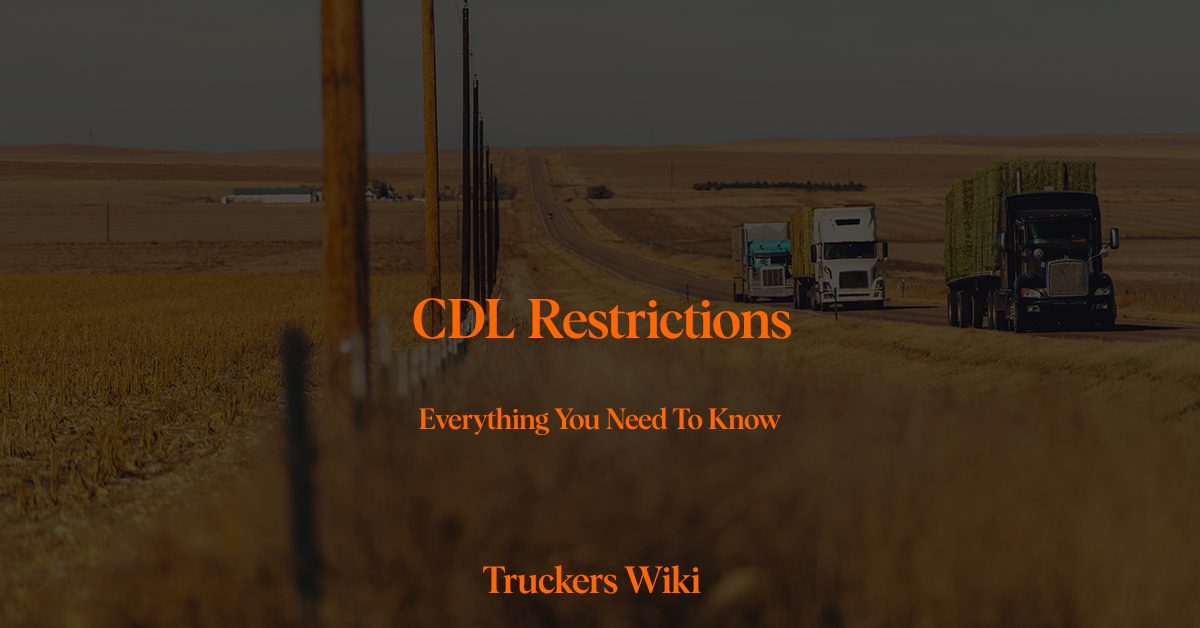
Table of Contents
What is a CDL Restriction
CDL Restriction often reflect a driver’s ability, experience, or comfort level with certain vehicles or equipment. They can also be a result of a driver’s physical condition. CDL restrictions ensure that drivers operate vehicles safely and according to their abilities. Some restrictions can be removed with additional testing or medical clearance, while others may be permanent.
Common CDL Restrictions
Here are some of the most common restrictions that might be placed on a CDL:
1. L Restriction – Air Brakes
If a driver takes the CDL skills test in a vehicle not equipped with air brakes, the driver is restricted from operating a CMV equipped with air brakes. This restriction can be removed if the driver successfully passes an air brakes knowledge test and a skills test in a vehicle equipped with air brakes.
Learn more about Air Brakes Restriction – L Restriction and how to remove it here.
2. E Restriction – No Manual Transmission
Driver who takes their skills test in a vehicle equipped with an automatic transmission will have an “E” restriction placed on their license, indicating they are not authorized to operate a vehicle with a manual transmission.
Learn more about No Manual Transmission – E Restriction and how to remove it here.
3. Z Restriction – No Full Air Brake Equipped CMV
This restriction is placed on a driver who takes the skills test in a vehicle equipped with an air over hydraulic brake system. The Z restriction indicates that the CDL holder can only operate a CMV equipped with either full air brakes or air over hydraulic brakes.
Learn more about No Full Air Brake Equipped CMV – Z Restriction and how to remove it here.
4. K Restriction – Intrastate Driving Only
A driver with a K restriction on their license is only authorized to drive commercially within the boundaries of the state where the license was issued. This restriction is often placed on a CDL due to medical conditions.
Learn more about Intrastate Driving Only – K Restriction here.
5. M Restriction – Class B or C Passenger Vehicle
This restriction applies to a Class A CDL holder who has taken the skills test in a Class B or C passenger vehicle. This driver is restricted from operating a Class A passenger vehicle.
Learn more about Class B or C Passenger Vehicle – M Restriction and how to remove it here.
6. N Restriction – Class C Passenger Vehicle
This restriction is placed on a Class A or B CDL holder who has taken the skills test in a Class C passenger vehicle. This driver is restricted from operating a Class A or B passenger vehicle.
Learn more about Class C Passenger Vehicle – N Restriction here.
7. O Restriction – No Tractor-Trailer CMV
The O restriction is placed on a driver who takes the skills test in a non-tractor-trailer combination vehicle. This driver is restricted from operating a tractor-trailer combination vehicle.
Learn more about No Tractor-Trailer CMV – O Restriction and how to remove it here.
8. V Restriction – Medical Variance
If a driver has been issued a medical variance by the Federal Motor Carrier Safety Administration (FMCSA), they will have a V restriction placed on their CDL.
Learn more about Medical Variance – V Restriction here.
9. X Restriction – No Cargo in CMV Tank Vehicle
This restriction is placed on a driver who has a tank vehicle endorsement but is prohibited from transporting cargo in a tank vehicle.
Learn more about No Cargo in CMV Tank Vehicle – X Restriction and how to remove it here.
Removing CDL Restrictions
Restrictions based on the type of vehicle used during the skills test can usually be removed by retaking the test with the correct vehicle. For example, if a driver has an E restriction for using an automatic transmission vehicle during testing, they can have the restriction removed by retaking the test with a manual transmission vehicle.
Medical restrictions, like the K restriction for intrastate driving, can sometimes be removed or altered if a driver’s medical condition improves or changes. For instance, if a driver has been granted a medical variance by the FMCSA (noted with a V restriction), their restriction status might change if their medical condition changes and is approved by the FMCSA.
Importance of Understanding CDL Restrictions
Understanding CDL restrictions is critical for both drivers and their employers. Drivers need to know the limitations of their license to ensure they are operating vehicles legally and safely. Employers also need to be aware of any restrictions to make certain they are not assigning tasks that are outside the legal capabilities of their drivers.
Not abiding by CDL restrictions can result in legal consequences for both drivers and employers, such as fines, points against the CDL, or even the suspension or revocation of the CDL.
Learn more about Vision Requirements & Restrictions on CDL here.
Listen to The Article Here
Last modified: August 22, 2023

